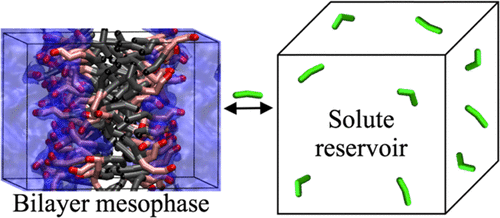Our official English website, www.x-mol.net, welcomes your
feedback! (Note: you will need to create a separate account there.)
Probing Additive Loading in the Lamellar Phase of a Nonionic Surfactant: Gibbs Ensemble Monte Carlo Simulations Using the SDK Force Field
Langmuir ( IF 3.7 ) Pub Date : 2018-06-14 00:00:00 , DOI: 10.1021/acs.langmuir.8b00687 Mona S Minkara 1 , Rebecca K Lindsey 1 , Celeste O. Noether 1 , Connor L Venteicher 1 , Sumanth N Jamadagni 2 , David M Eike 2 , Ahmad F Ghobadi 2 , Peter H Koenig 2 , J Ilja Siepmann 1, 3
Langmuir ( IF 3.7 ) Pub Date : 2018-06-14 00:00:00 , DOI: 10.1021/acs.langmuir.8b00687 Mona S Minkara 1 , Rebecca K Lindsey 1 , Celeste O. Noether 1 , Connor L Venteicher 1 , Sumanth N Jamadagni 2 , David M Eike 2 , Ahmad F Ghobadi 2 , Peter H Koenig 2 , J Ilja Siepmann 1, 3
Affiliation

|
Understanding solute uptake into soft microstructured materials, such as bilayers and worm-like and spherical micelles, is of interest in the pharmaceutical, agricultural, and personal care industries. To obtain molecular-level insight on the effects of solutes loading into a lamellar phase, we utilize the Shinoda–Devane–Klein (SDK) coarse-grained force field in conjunction with configurational-bias Monte Carlo simulations in the osmotic Gibbs ensemble. The lamellar phase is comprised of a bilayer formed by triethylene glycol mono-n-decyl ether (C10E3) surfactants surrounded by water with a 50:50 surfactant/water weight ratio. We study both the unary adsorption isotherm and the effects on bilayer structure and stability caused by n-nonane, 1-hexanol, and ethyl butyrate at several different reduced reservoir pressures. The nonpolar n-nonane molecules load near the center of the bilayer. In contrast, the polar 1-hexanol and ethyl butyrate molecules both load with their polar bead close to the surfactant head groups. Near the center of the bilayer, none of the solute molecules exhibits a significant orientational preference. Solute molecules adsorbed near the polar groups of the surfactant chains show a preference for orientations perpendicular to the interface, and this alignment with the long axis of the surfactant molecules is most pronounced for 1-hexanol. Loading of n-nonane leads to an increase of the bilayer thickness, but does not affect the surface area per surfactant. Loading of polar additives leads to both lateral and transverse swelling. The reduced Henry’s law constants of adsorption (expressed as a molar ratio of additive to surfactant per reduced pressure) are 0.23, 1.4, and 14 for n-nonane, 1-hexanol, and ethyl butyrate, respectively, and it appears that the SDK force field significantly overestimates the ethyl butyrate–surfactant interactions.
中文翻译:

探测非离子表面活性剂层状相中的添加剂负载:使用 SDK 力场进行吉布斯系综蒙特卡罗模拟
了解软微结构材料(例如双层、蠕虫状和球形胶束)对溶质的吸收引起了制药、农业和个人护理行业的兴趣。为了在分子水平上了解溶质加载到层状相的影响,我们利用 Shinoda-Devane-Klein (SDK) 粗粒度力场结合渗透吉布斯系综中的构型偏差蒙特卡罗模拟。层状相由三甘醇单正癸基醚(C10E3)表面活性剂形成的双层组成,该双层被水包围,表面活性剂/水的重量比为50:50。我们研究了一元吸附等温线以及正壬烷、1-己醇和丁酸乙酯在几种不同的降低的储层压力下对双层结构和稳定性的影响。非极性正壬烷分子负载在双层的中心附近。相反,极性 1-己醇和丁酸乙酯分子的极性珠都靠近表面活性剂头基。在双层中心附近,没有任何溶质分子表现出显着的取向偏好。吸附在表面活性剂链极性基团附近的溶质分子显示出倾向于垂直于界面的取向,并且这种与表面活性剂分子长轴的排列对于1-己醇最为明显。正壬烷的负载导致双层厚度的增加,但不影响每个表面活性剂的表面积。极性添加剂的加载导致侧向和横向膨胀。吸附的折合亨利定律常数(表示为每降低压力下添加剂与表面活性剂的摩尔比)为 0.23、1。正壬烷、1-己醇和丁酸乙酯分别为 4 和 14,并且 SDK 力场似乎显着高估了丁酸乙酯与表面活性剂的相互作用。
更新日期:2018-06-14
中文翻译:

探测非离子表面活性剂层状相中的添加剂负载:使用 SDK 力场进行吉布斯系综蒙特卡罗模拟
了解软微结构材料(例如双层、蠕虫状和球形胶束)对溶质的吸收引起了制药、农业和个人护理行业的兴趣。为了在分子水平上了解溶质加载到层状相的影响,我们利用 Shinoda-Devane-Klein (SDK) 粗粒度力场结合渗透吉布斯系综中的构型偏差蒙特卡罗模拟。层状相由三甘醇单正癸基醚(C10E3)表面活性剂形成的双层组成,该双层被水包围,表面活性剂/水的重量比为50:50。我们研究了一元吸附等温线以及正壬烷、1-己醇和丁酸乙酯在几种不同的降低的储层压力下对双层结构和稳定性的影响。非极性正壬烷分子负载在双层的中心附近。相反,极性 1-己醇和丁酸乙酯分子的极性珠都靠近表面活性剂头基。在双层中心附近,没有任何溶质分子表现出显着的取向偏好。吸附在表面活性剂链极性基团附近的溶质分子显示出倾向于垂直于界面的取向,并且这种与表面活性剂分子长轴的排列对于1-己醇最为明显。正壬烷的负载导致双层厚度的增加,但不影响每个表面活性剂的表面积。极性添加剂的加载导致侧向和横向膨胀。吸附的折合亨利定律常数(表示为每降低压力下添加剂与表面活性剂的摩尔比)为 0.23、1。正壬烷、1-己醇和丁酸乙酯分别为 4 和 14,并且 SDK 力场似乎显着高估了丁酸乙酯与表面活性剂的相互作用。











































 京公网安备 11010802027423号
京公网安备 11010802027423号